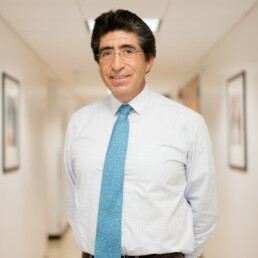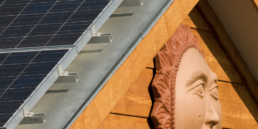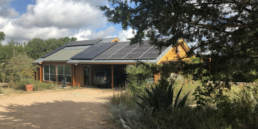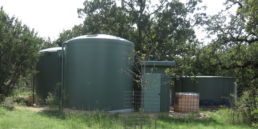Carlos Torres-Verdín forged a bond with nature at an early age. As an avid hiker and climber, he grew up traversing the trails and scaling the mountain peaks near Mexico City, developing a fascination with rocks along the way.
Years later, this connection to nature remains present in Torres-Verdín’s day-to-day life. The passion for climbing has yet to recede. Torres-Verdín has summited many of the highest peaks in the Pacific Northwest over the years. He has also completed 21 marathons and more than 400 half marathons.
He and his wife, Laurel Treviño-Murphy, a plant biologist with an emphasis on conservation and education outreach, have spent more than a decade curating a shrine to sustainability at their 10-acre property in the southwest Austin area. They collect and use rainwater for all their home needs, including drinking. They’ve created a native haven
of local plants. And 85% of the energy they use comes from solar panels.
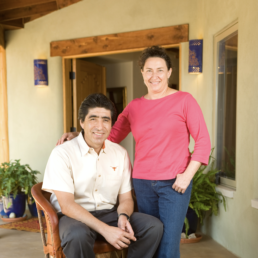
CARLOS TORRES-VERDÍN AND HIS WIFE, LAUREL TREVIÑO-MURPHY
This lifestyle led Torres-Verdín to a career in a field that isn’t always thought of as environmentally sustainable — he is a leader in developing technology that makes detecting and extracting important resources such as oil, gas and water from the subsurface, more efficient. But it’s his passion for the environment that drives his desire to improve how we get natural resources to make sure the process does minimal harm and is sustainable.
“Many of the resources we need come from beneath the subsurface, and the last thing I want to do is see the land damaged. When we’re procuring these resources, it’s important to do it in a socially responsible way, protecting the environment, so that we best use and preserve what Mother Earth has given us.”
-Torres-Verdín
Torres-Verdín is a professor in the Cockrell School’s Hildebrand Department of Petroleum and Geosystems Engineering, and he leads the Center of Excellence in Formation Evaluation, a research consortium that celebrated its 20th anniversary last year.
The consortium has been awarded nearly $25 million in research funding from affiliate partners in the energy industry over its lifetime. And it has brought some of the biggest names in energy to the table: Chevron, BP, Shell, ExxonMobil, ConocoPhillips, Schlumberger and Halliburton are among the more than current 20 affiliates.
Formation evaluation is a method of sensing and quantifying the properties of rocks under the surface of the earth, especially the rocks around a wellbore, such as mineral composition, how much fluid they store and how efficiently they can release those fluids.
Think of the concept like an MRI for rocks and the earth’s subsurface. The technology includes ways to acquire real-time measurements while drilling to guide equipment safely and efficiently toward the target or to image
3D rock properties around and ahead of the drill bit.

Attendees of the Center of Excellence in Formation Evaluation Consortium’s 19th anniversary event.
Over the more than 20 years of the consortium’s existence, its researchers have made several major advancements in developing formation evaluation:
- First to develop engineering methods to estimate how fast or slow fluids move through complex rocks based on the effect that drilling fluids have on them
- New physics-based numerical models that can estimate the composition of rocks and tell what types of fluids are inside and their concentrations; based on novel ways to rapidly simulate borehole nuclear measurements, also developed by Torres-Verdín’s research group
- A new method for rapidly simulating and interpreting borehole acoustic measurements for quantifying the elastic and mechanical properties of rocks around the wellbore.
The latter developments are being routinely used by service and operating companies around the world to enhance the interpretations of their measurements, thereby improving the efficiency of their exploration and development projects. His group has recently implemented the same technology for the study of Texas aquifers.
Torres-Verdín’s connection to nature was one piece of the puzzle that led him to his field. His interest in physics was another. He knew in high school he wanted to be a physicist — he loved to use physics and math to solve problems — but he wasn’t sure what kind.
At one point, an acquaintance took him to visit a civil engineering firm. They were getting ready to lay down pavement and wanted to get a sense of how the surface underneath it would change over time. Instead of doing the conventional thing, drilling a small hole to take a probe, they wanted to use remote-sensing techniques that didn’t require breaking ground.
This, Torres-Verdín said, blew his mind. And it drove his interest in geophysics.
Since I was a student, I’ve always been very interested in learning about how these remote-sensing techniques work, where we could sense things in the subsurface without having to drill,
he said.
In the late 1990s the idea that one could get an accurate 3D picture of the subsurface around a wellbore had not been fully realized. Torres-Verdín saw the problems firsthand working at companies such as the Mexican Petroleum Institute, Schlumberger-Doll Research and YPF S.A. in Argentina.
The research consortium was created through research contracts with and donations from major industry players. And Torres-Verdín’s experience in the field and academic curiosity made him the perfect person to establish and grow it.
In its over 21 years, the consortium has become the most well-known research group in the world focused on formation evaluation, Torres-Verdín said. It has graduated 35 Ph.D. students and 52 master’s degree students. Researchers from the consortium have published more than 450 papers in the group’s lifetime.
When Torres-Verdín came to UT in 1999, there was virtually zero academic research in the U.S. devoted to formation evaluation. That has changed over the last 21 years, and his consortium is a big reason why.
Four of my students have gone on to become professors at other universities, and some have founded similar or related research centers,
Torres-Verdín said. Now I have to compete with them for funding sometimes. I created my own competition, but I love it and treasure it because it is enriching and diverse. I am very proud of what my former students have and are accomplishing worldwide; I continue to learn from them.
by Nat Levy
